Enhancing Leadership and Change in UnitedHealth Group: A Report
VerifiedAdded on 2023/06/04
|8
|1873
|231
Report
AI Summary
This report identifies demotivation factors, leadership issues, and ineffective communication systems within UnitedHealth Group. The analysis reveals that a lack of clear communication, poor relationships between peers and supervisors, and a perceived lack of job security contribute to low employee morale and productivity. Recommendations include implementing more direct communication strategies, establishing a formal chain of command, and actively soliciting employee feedback through surveys and individual meetings to identify and reinforce motivational factors. The proposed implementation plan involves hiring skilled personnel to train both employees and managers in effective communication practices, fostering a more transparent and supportive work environment. The goal is to enhance overall employee motivation, improve work relationships, and ultimately increase revenue for UnitedHealth Group. Desklib provides access to this and other solved assignments for students.
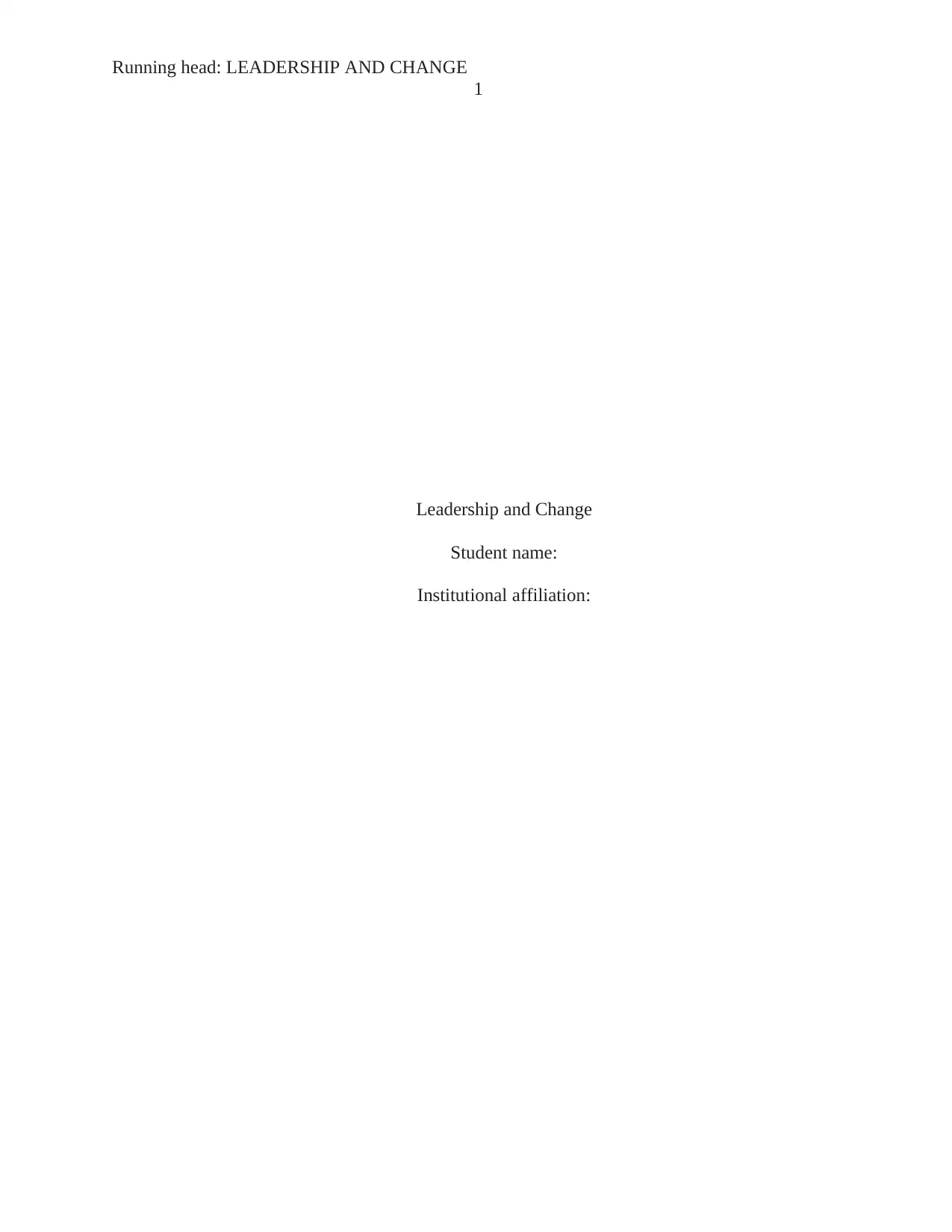
Running head: LEADERSHIP AND CHANGE
1
Leadership and Change
Student name:
Institutional affiliation:
1
Leadership and Change
Student name:
Institutional affiliation:
Paraphrase This Document
Need a fresh take? Get an instant paraphrase of this document with our AI Paraphraser
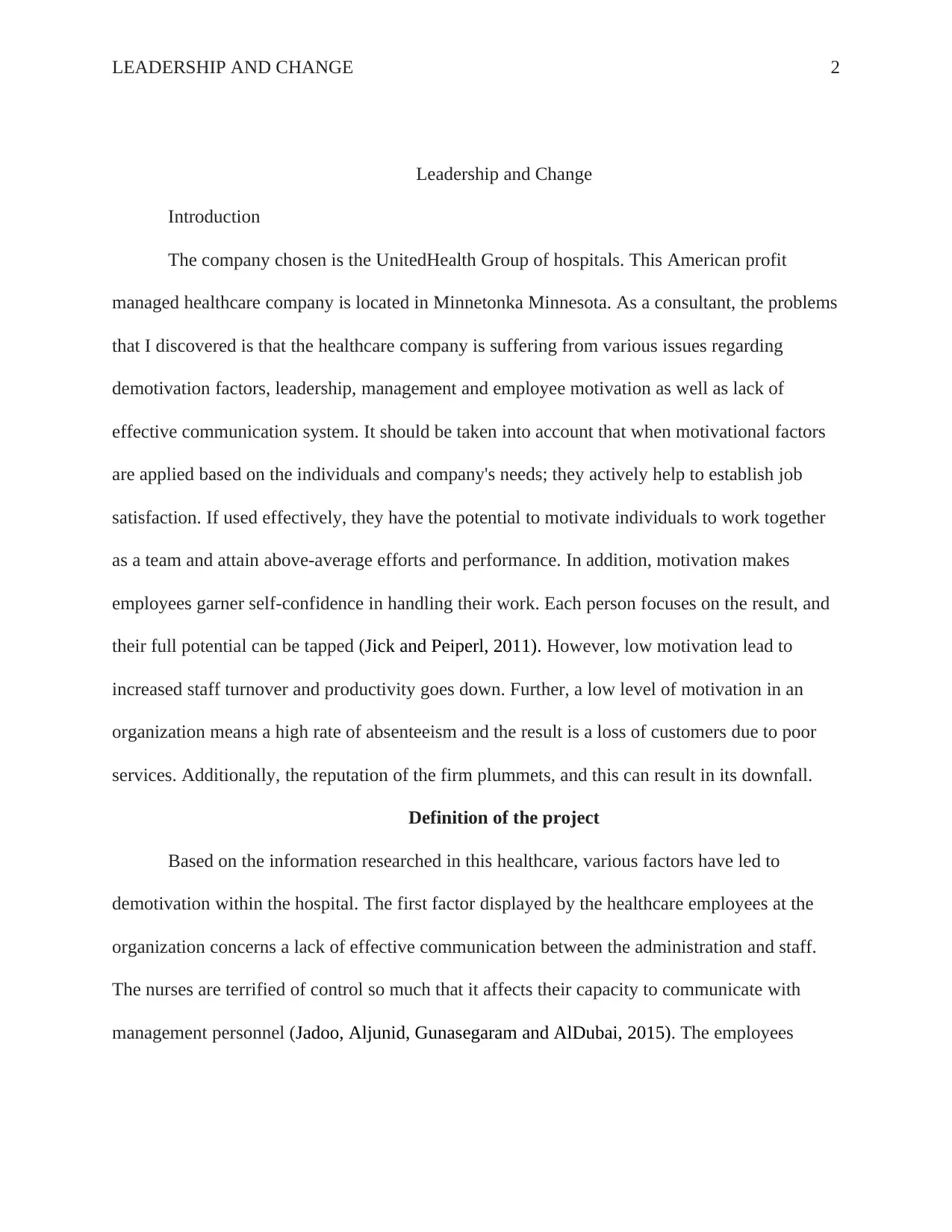
LEADERSHIP AND CHANGE 2
Leadership and Change
Introduction
The company chosen is the UnitedHealth Group of hospitals. This American profit
managed healthcare company is located in Minnetonka Minnesota. As a consultant, the problems
that I discovered is that the healthcare company is suffering from various issues regarding
demotivation factors, leadership, management and employee motivation as well as lack of
effective communication system. It should be taken into account that when motivational factors
are applied based on the individuals and company's needs; they actively help to establish job
satisfaction. If used effectively, they have the potential to motivate individuals to work together
as a team and attain above-average efforts and performance. In addition, motivation makes
employees garner self-confidence in handling their work. Each person focuses on the result, and
their full potential can be tapped (Jick and Peiperl, 2011). However, low motivation lead to
increased staff turnover and productivity goes down. Further, a low level of motivation in an
organization means a high rate of absenteeism and the result is a loss of customers due to poor
services. Additionally, the reputation of the firm plummets, and this can result in its downfall.
Definition of the project
Based on the information researched in this healthcare, various factors have led to
demotivation within the hospital. The first factor displayed by the healthcare employees at the
organization concerns a lack of effective communication between the administration and staff.
The nurses are terrified of control so much that it affects their capacity to communicate with
management personnel (Jadoo, Aljunid, Gunasegaram and AlDubai, 2015). The employees
Leadership and Change
Introduction
The company chosen is the UnitedHealth Group of hospitals. This American profit
managed healthcare company is located in Minnetonka Minnesota. As a consultant, the problems
that I discovered is that the healthcare company is suffering from various issues regarding
demotivation factors, leadership, management and employee motivation as well as lack of
effective communication system. It should be taken into account that when motivational factors
are applied based on the individuals and company's needs; they actively help to establish job
satisfaction. If used effectively, they have the potential to motivate individuals to work together
as a team and attain above-average efforts and performance. In addition, motivation makes
employees garner self-confidence in handling their work. Each person focuses on the result, and
their full potential can be tapped (Jick and Peiperl, 2011). However, low motivation lead to
increased staff turnover and productivity goes down. Further, a low level of motivation in an
organization means a high rate of absenteeism and the result is a loss of customers due to poor
services. Additionally, the reputation of the firm plummets, and this can result in its downfall.
Definition of the project
Based on the information researched in this healthcare, various factors have led to
demotivation within the hospital. The first factor displayed by the healthcare employees at the
organization concerns a lack of effective communication between the administration and staff.
The nurses are terrified of control so much that it affects their capacity to communicate with
management personnel (Jadoo, Aljunid, Gunasegaram and AlDubai, 2015). The employees
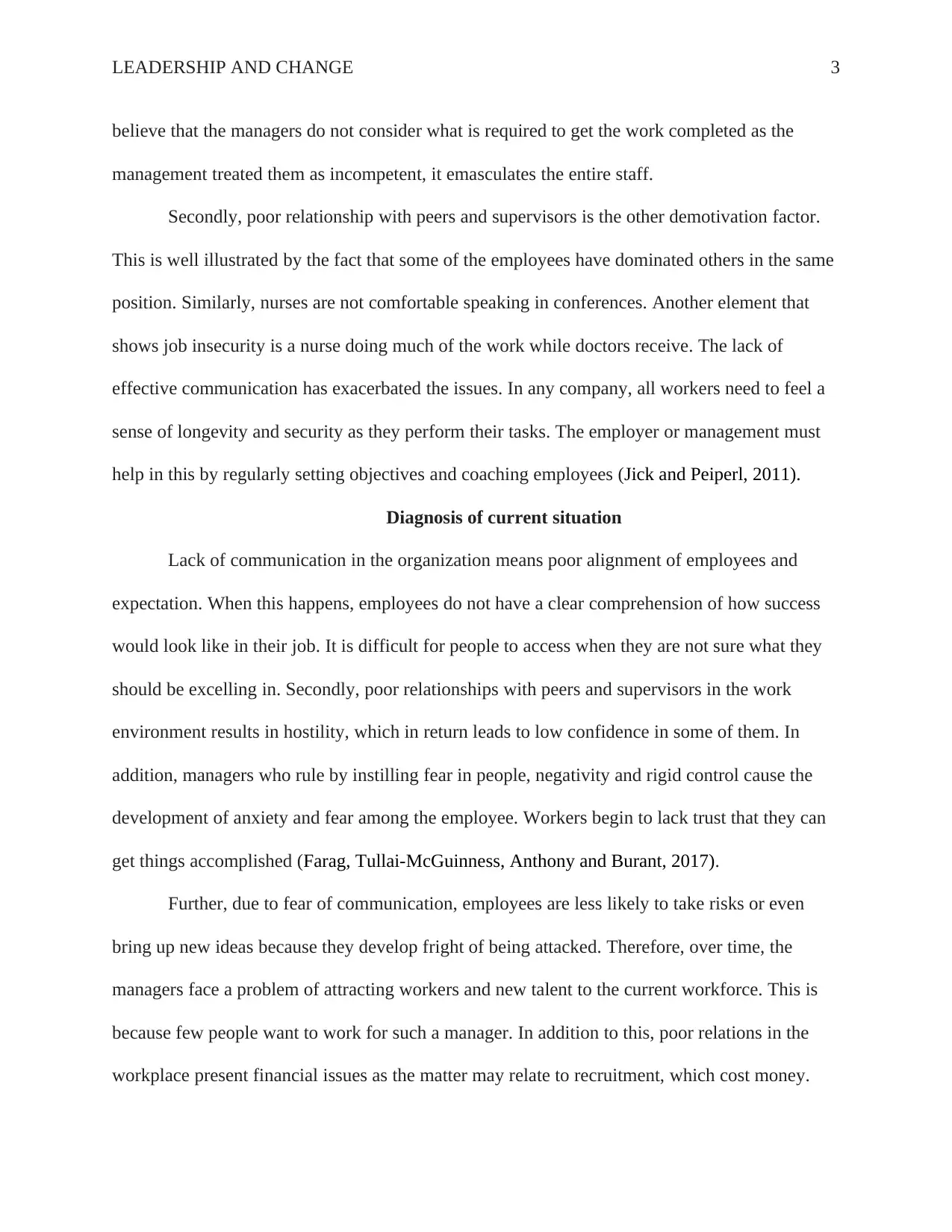
LEADERSHIP AND CHANGE 3
believe that the managers do not consider what is required to get the work completed as the
management treated them as incompetent, it emasculates the entire staff.
Secondly, poor relationship with peers and supervisors is the other demotivation factor.
This is well illustrated by the fact that some of the employees have dominated others in the same
position. Similarly, nurses are not comfortable speaking in conferences. Another element that
shows job insecurity is a nurse doing much of the work while doctors receive. The lack of
effective communication has exacerbated the issues. In any company, all workers need to feel a
sense of longevity and security as they perform their tasks. The employer or management must
help in this by regularly setting objectives and coaching employees (Jick and Peiperl, 2011).
Diagnosis of current situation
Lack of communication in the organization means poor alignment of employees and
expectation. When this happens, employees do not have a clear comprehension of how success
would look like in their job. It is difficult for people to access when they are not sure what they
should be excelling in. Secondly, poor relationships with peers and supervisors in the work
environment results in hostility, which in return leads to low confidence in some of them. In
addition, managers who rule by instilling fear in people, negativity and rigid control cause the
development of anxiety and fear among the employee. Workers begin to lack trust that they can
get things accomplished (Farag, Tullai-McGuinness, Anthony and Burant, 2017).
Further, due to fear of communication, employees are less likely to take risks or even
bring up new ideas because they develop fright of being attacked. Therefore, over time, the
managers face a problem of attracting workers and new talent to the current workforce. This is
because few people want to work for such a manager. In addition to this, poor relations in the
workplace present financial issues as the matter may relate to recruitment, which cost money.
believe that the managers do not consider what is required to get the work completed as the
management treated them as incompetent, it emasculates the entire staff.
Secondly, poor relationship with peers and supervisors is the other demotivation factor.
This is well illustrated by the fact that some of the employees have dominated others in the same
position. Similarly, nurses are not comfortable speaking in conferences. Another element that
shows job insecurity is a nurse doing much of the work while doctors receive. The lack of
effective communication has exacerbated the issues. In any company, all workers need to feel a
sense of longevity and security as they perform their tasks. The employer or management must
help in this by regularly setting objectives and coaching employees (Jick and Peiperl, 2011).
Diagnosis of current situation
Lack of communication in the organization means poor alignment of employees and
expectation. When this happens, employees do not have a clear comprehension of how success
would look like in their job. It is difficult for people to access when they are not sure what they
should be excelling in. Secondly, poor relationships with peers and supervisors in the work
environment results in hostility, which in return leads to low confidence in some of them. In
addition, managers who rule by instilling fear in people, negativity and rigid control cause the
development of anxiety and fear among the employee. Workers begin to lack trust that they can
get things accomplished (Farag, Tullai-McGuinness, Anthony and Burant, 2017).
Further, due to fear of communication, employees are less likely to take risks or even
bring up new ideas because they develop fright of being attacked. Therefore, over time, the
managers face a problem of attracting workers and new talent to the current workforce. This is
because few people want to work for such a manager. In addition to this, poor relations in the
workplace present financial issues as the matter may relate to recruitment, which cost money.
⊘ This is a preview!⊘
Do you want full access?
Subscribe today to unlock all pages.

Trusted by 1+ million students worldwide
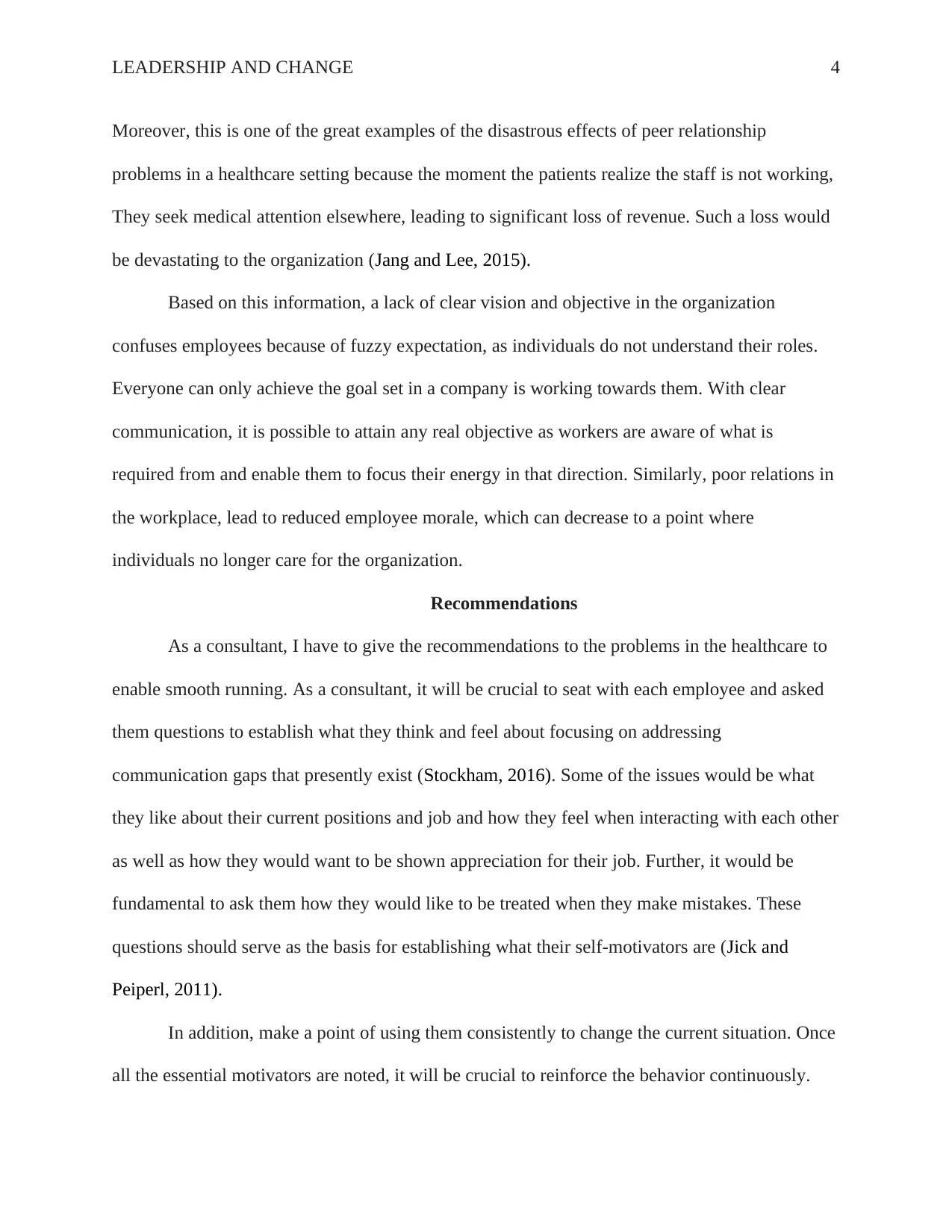
LEADERSHIP AND CHANGE 4
Moreover, this is one of the great examples of the disastrous effects of peer relationship
problems in a healthcare setting because the moment the patients realize the staff is not working,
They seek medical attention elsewhere, leading to significant loss of revenue. Such a loss would
be devastating to the organization (Jang and Lee, 2015).
Based on this information, a lack of clear vision and objective in the organization
confuses employees because of fuzzy expectation, as individuals do not understand their roles.
Everyone can only achieve the goal set in a company is working towards them. With clear
communication, it is possible to attain any real objective as workers are aware of what is
required from and enable them to focus their energy in that direction. Similarly, poor relations in
the workplace, lead to reduced employee morale, which can decrease to a point where
individuals no longer care for the organization.
Recommendations
As a consultant, I have to give the recommendations to the problems in the healthcare to
enable smooth running. As a consultant, it will be crucial to seat with each employee and asked
them questions to establish what they think and feel about focusing on addressing
communication gaps that presently exist (Stockham, 2016). Some of the issues would be what
they like about their current positions and job and how they feel when interacting with each other
as well as how they would want to be shown appreciation for their job. Further, it would be
fundamental to ask them how they would like to be treated when they make mistakes. These
questions should serve as the basis for establishing what their self-motivators are (Jick and
Peiperl, 2011).
In addition, make a point of using them consistently to change the current situation. Once
all the essential motivators are noted, it will be crucial to reinforce the behavior continuously.
Moreover, this is one of the great examples of the disastrous effects of peer relationship
problems in a healthcare setting because the moment the patients realize the staff is not working,
They seek medical attention elsewhere, leading to significant loss of revenue. Such a loss would
be devastating to the organization (Jang and Lee, 2015).
Based on this information, a lack of clear vision and objective in the organization
confuses employees because of fuzzy expectation, as individuals do not understand their roles.
Everyone can only achieve the goal set in a company is working towards them. With clear
communication, it is possible to attain any real objective as workers are aware of what is
required from and enable them to focus their energy in that direction. Similarly, poor relations in
the workplace, lead to reduced employee morale, which can decrease to a point where
individuals no longer care for the organization.
Recommendations
As a consultant, I have to give the recommendations to the problems in the healthcare to
enable smooth running. As a consultant, it will be crucial to seat with each employee and asked
them questions to establish what they think and feel about focusing on addressing
communication gaps that presently exist (Stockham, 2016). Some of the issues would be what
they like about their current positions and job and how they feel when interacting with each other
as well as how they would want to be shown appreciation for their job. Further, it would be
fundamental to ask them how they would like to be treated when they make mistakes. These
questions should serve as the basis for establishing what their self-motivators are (Jick and
Peiperl, 2011).
In addition, make a point of using them consistently to change the current situation. Once
all the essential motivators are noted, it will be crucial to reinforce the behavior continuously.
Paraphrase This Document
Need a fresh take? Get an instant paraphrase of this document with our AI Paraphraser
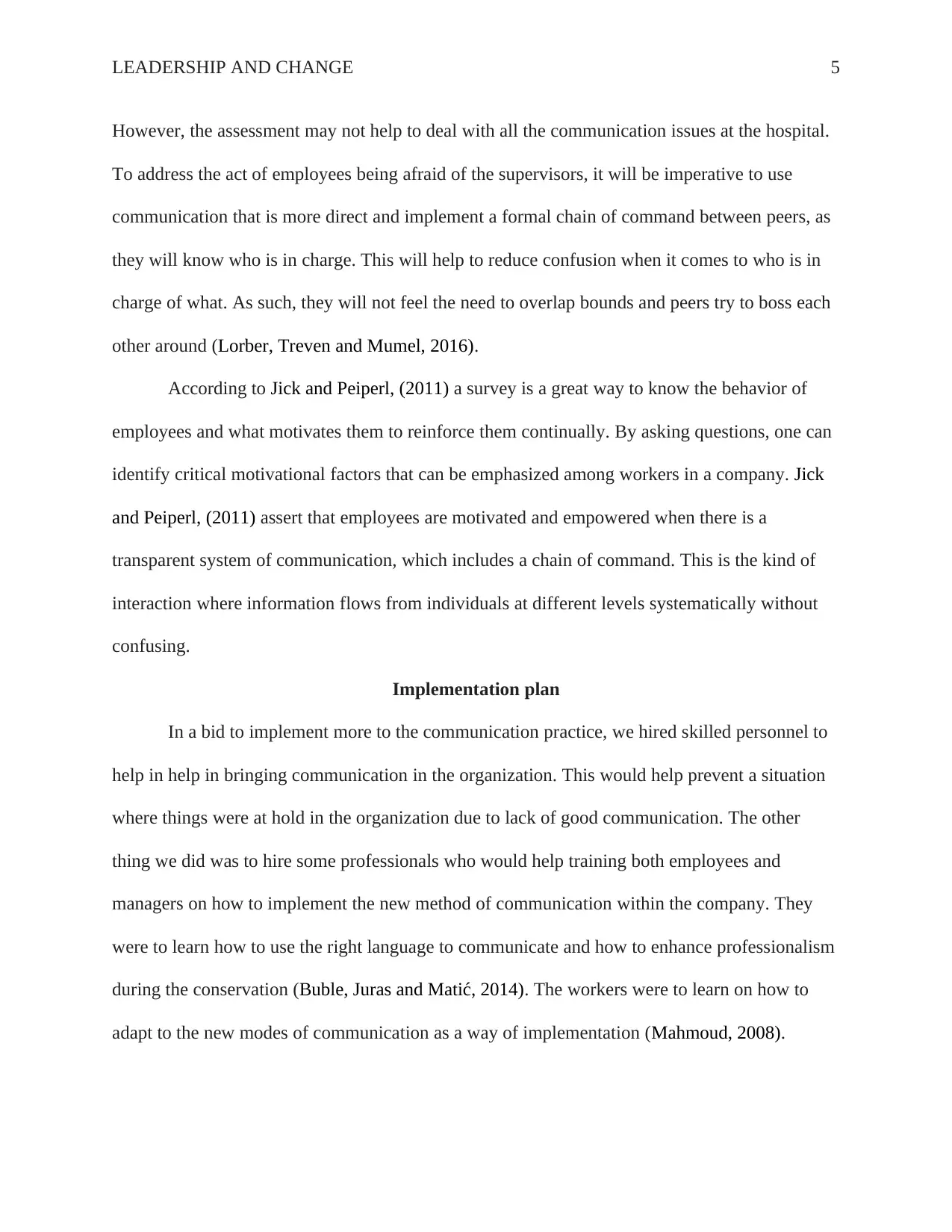
LEADERSHIP AND CHANGE 5
However, the assessment may not help to deal with all the communication issues at the hospital.
To address the act of employees being afraid of the supervisors, it will be imperative to use
communication that is more direct and implement a formal chain of command between peers, as
they will know who is in charge. This will help to reduce confusion when it comes to who is in
charge of what. As such, they will not feel the need to overlap bounds and peers try to boss each
other around (Lorber, Treven and Mumel, 2016).
According to Jick and Peiperl, (2011) a survey is a great way to know the behavior of
employees and what motivates them to reinforce them continually. By asking questions, one can
identify critical motivational factors that can be emphasized among workers in a company. Jick
and Peiperl, (2011) assert that employees are motivated and empowered when there is a
transparent system of communication, which includes a chain of command. This is the kind of
interaction where information flows from individuals at different levels systematically without
confusing.
Implementation plan
In a bid to implement more to the communication practice, we hired skilled personnel to
help in help in bringing communication in the organization. This would help prevent a situation
where things were at hold in the organization due to lack of good communication. The other
thing we did was to hire some professionals who would help training both employees and
managers on how to implement the new method of communication within the company. They
were to learn how to use the right language to communicate and how to enhance professionalism
during the conservation (Buble, Juras and Matić, 2014). The workers were to learn on how to
adapt to the new modes of communication as a way of implementation (Mahmoud, 2008).
However, the assessment may not help to deal with all the communication issues at the hospital.
To address the act of employees being afraid of the supervisors, it will be imperative to use
communication that is more direct and implement a formal chain of command between peers, as
they will know who is in charge. This will help to reduce confusion when it comes to who is in
charge of what. As such, they will not feel the need to overlap bounds and peers try to boss each
other around (Lorber, Treven and Mumel, 2016).
According to Jick and Peiperl, (2011) a survey is a great way to know the behavior of
employees and what motivates them to reinforce them continually. By asking questions, one can
identify critical motivational factors that can be emphasized among workers in a company. Jick
and Peiperl, (2011) assert that employees are motivated and empowered when there is a
transparent system of communication, which includes a chain of command. This is the kind of
interaction where information flows from individuals at different levels systematically without
confusing.
Implementation plan
In a bid to implement more to the communication practice, we hired skilled personnel to
help in help in bringing communication in the organization. This would help prevent a situation
where things were at hold in the organization due to lack of good communication. The other
thing we did was to hire some professionals who would help training both employees and
managers on how to implement the new method of communication within the company. They
were to learn how to use the right language to communicate and how to enhance professionalism
during the conservation (Buble, Juras and Matić, 2014). The workers were to learn on how to
adapt to the new modes of communication as a way of implementation (Mahmoud, 2008).
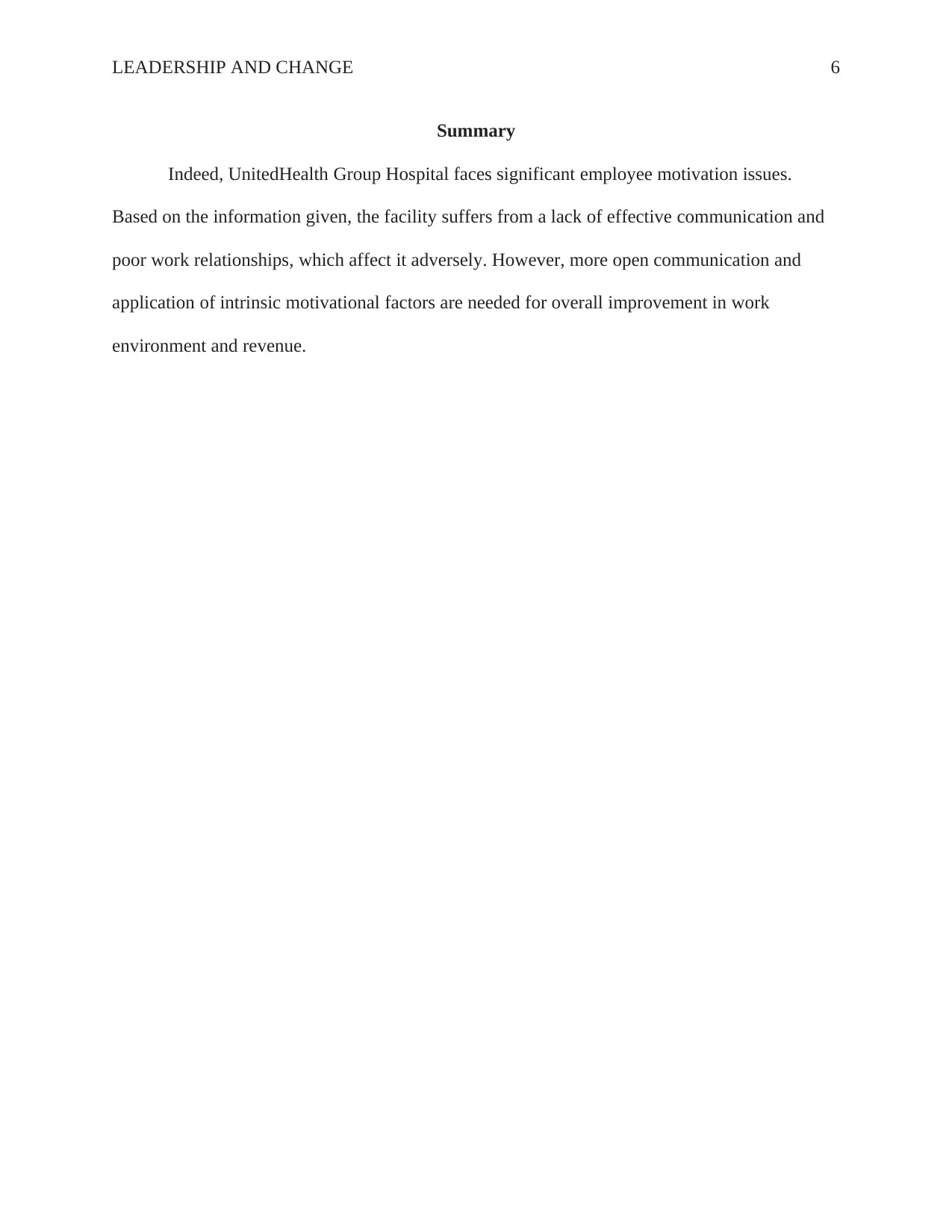
LEADERSHIP AND CHANGE 6
Summary
Indeed, UnitedHealth Group Hospital faces significant employee motivation issues.
Based on the information given, the facility suffers from a lack of effective communication and
poor work relationships, which affect it adversely. However, more open communication and
application of intrinsic motivational factors are needed for overall improvement in work
environment and revenue.
Summary
Indeed, UnitedHealth Group Hospital faces significant employee motivation issues.
Based on the information given, the facility suffers from a lack of effective communication and
poor work relationships, which affect it adversely. However, more open communication and
application of intrinsic motivational factors are needed for overall improvement in work
environment and revenue.
⊘ This is a preview!⊘
Do you want full access?
Subscribe today to unlock all pages.

Trusted by 1+ million students worldwide
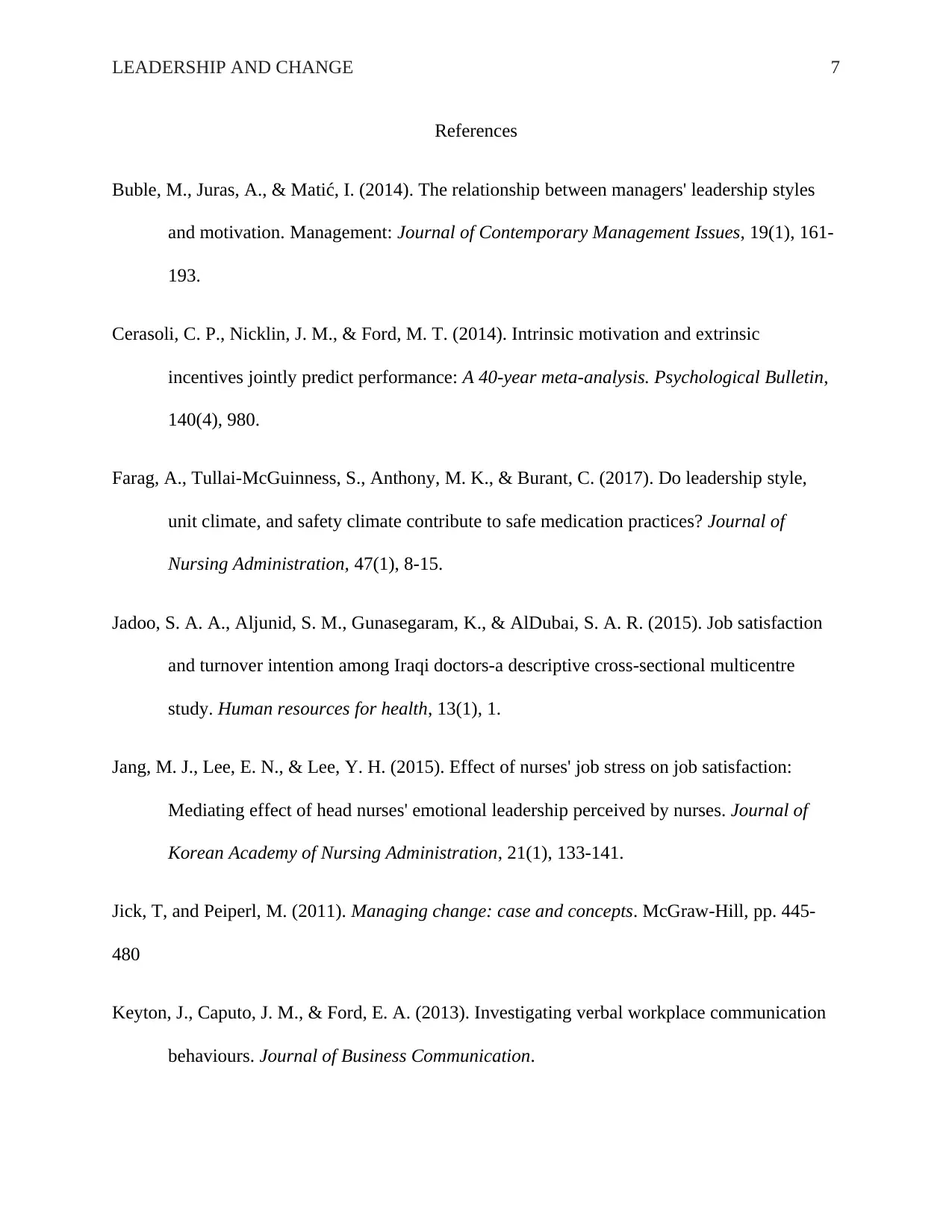
LEADERSHIP AND CHANGE 7
References
Buble, M., Juras, A., & Matić, I. (2014). The relationship between managers' leadership styles
and motivation. Management: Journal of Contemporary Management Issues, 19(1), 161-
193.
Cerasoli, C. P., Nicklin, J. M., & Ford, M. T. (2014). Intrinsic motivation and extrinsic
incentives jointly predict performance: A 40-year meta-analysis. Psychological Bulletin,
140(4), 980.
Farag, A., Tullai-McGuinness, S., Anthony, M. K., & Burant, C. (2017). Do leadership style,
unit climate, and safety climate contribute to safe medication practices? Journal of
Nursing Administration, 47(1), 8-15.
Jadoo, S. A. A., Aljunid, S. M., Gunasegaram, K., & AlDubai, S. A. R. (2015). Job satisfaction
and turnover intention among Iraqi doctors-a descriptive cross-sectional multicentre
study. Human resources for health, 13(1), 1.
Jang, M. J., Lee, E. N., & Lee, Y. H. (2015). Effect of nurses' job stress on job satisfaction:
Mediating effect of head nurses' emotional leadership perceived by nurses. Journal of
Korean Academy of Nursing Administration, 21(1), 133-141.
Jick, T, and Peiperl, M. (2011). Managing change: case and concepts. McGraw-Hill, pp. 445-
480
Keyton, J., Caputo, J. M., & Ford, E. A. (2013). Investigating verbal workplace communication
behaviours. Journal of Business Communication.
References
Buble, M., Juras, A., & Matić, I. (2014). The relationship between managers' leadership styles
and motivation. Management: Journal of Contemporary Management Issues, 19(1), 161-
193.
Cerasoli, C. P., Nicklin, J. M., & Ford, M. T. (2014). Intrinsic motivation and extrinsic
incentives jointly predict performance: A 40-year meta-analysis. Psychological Bulletin,
140(4), 980.
Farag, A., Tullai-McGuinness, S., Anthony, M. K., & Burant, C. (2017). Do leadership style,
unit climate, and safety climate contribute to safe medication practices? Journal of
Nursing Administration, 47(1), 8-15.
Jadoo, S. A. A., Aljunid, S. M., Gunasegaram, K., & AlDubai, S. A. R. (2015). Job satisfaction
and turnover intention among Iraqi doctors-a descriptive cross-sectional multicentre
study. Human resources for health, 13(1), 1.
Jang, M. J., Lee, E. N., & Lee, Y. H. (2015). Effect of nurses' job stress on job satisfaction:
Mediating effect of head nurses' emotional leadership perceived by nurses. Journal of
Korean Academy of Nursing Administration, 21(1), 133-141.
Jick, T, and Peiperl, M. (2011). Managing change: case and concepts. McGraw-Hill, pp. 445-
480
Keyton, J., Caputo, J. M., & Ford, E. A. (2013). Investigating verbal workplace communication
behaviours. Journal of Business Communication.
Paraphrase This Document
Need a fresh take? Get an instant paraphrase of this document with our AI Paraphraser
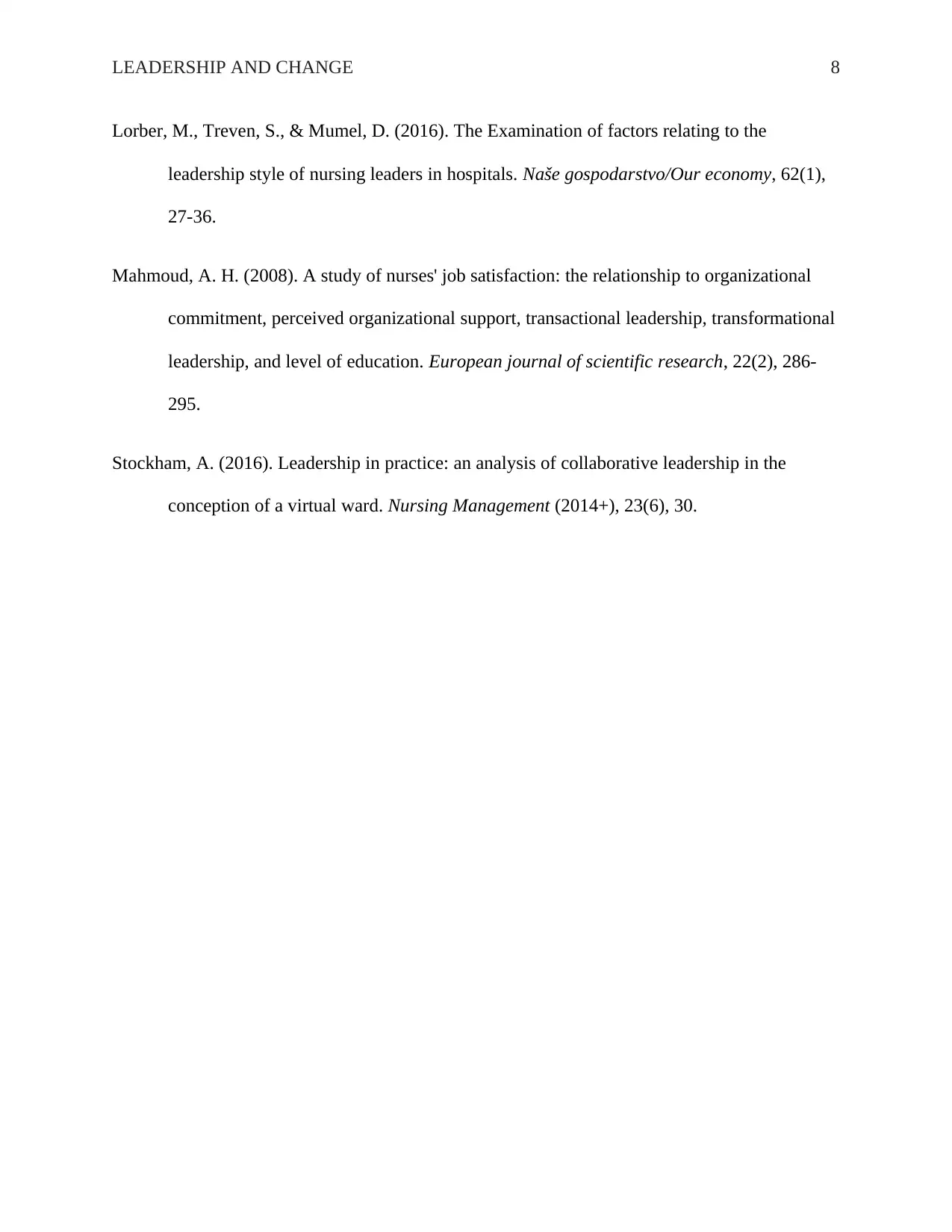
LEADERSHIP AND CHANGE 8
Lorber, M., Treven, S., & Mumel, D. (2016). The Examination of factors relating to the
leadership style of nursing leaders in hospitals. Naše gospodarstvo/Our economy, 62(1),
27-36.
Mahmoud, A. H. (2008). A study of nurses' job satisfaction: the relationship to organizational
commitment, perceived organizational support, transactional leadership, transformational
leadership, and level of education. European journal of scientific research, 22(2), 286-
295.
Stockham, A. (2016). Leadership in practice: an analysis of collaborative leadership in the
conception of a virtual ward. Nursing Management (2014+), 23(6), 30.
Lorber, M., Treven, S., & Mumel, D. (2016). The Examination of factors relating to the
leadership style of nursing leaders in hospitals. Naše gospodarstvo/Our economy, 62(1),
27-36.
Mahmoud, A. H. (2008). A study of nurses' job satisfaction: the relationship to organizational
commitment, perceived organizational support, transactional leadership, transformational
leadership, and level of education. European journal of scientific research, 22(2), 286-
295.
Stockham, A. (2016). Leadership in practice: an analysis of collaborative leadership in the
conception of a virtual ward. Nursing Management (2014+), 23(6), 30.
1 out of 8
Related Documents
Your All-in-One AI-Powered Toolkit for Academic Success.
+13062052269
info@desklib.com
Available 24*7 on WhatsApp / Email
![[object Object]](/_next/static/media/star-bottom.7253800d.svg)
Unlock your academic potential
Copyright © 2020–2025 A2Z Services. All Rights Reserved. Developed and managed by ZUCOL.





